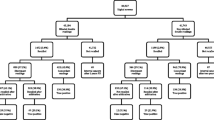Abstract
Purpose
The authors sought to assess the role of arbitration by a third reader of discordant double readings to reduce the rate of recalls to diagnostic assessment.
Materials and methods
A consecutive series of 7,660 double readings of screening examinations were considered. Discordant recalls were arbitrated by an expert reader (negative/positive). Diagnostic assessment was performed irrespective of arbitration results, and its outcome was used as reference standard for the study purpose. Assuming that negative arbitration would deny recall, its impact was assessed in terms of reduced recall rate and reduced cancer detection rate. Cost analysis of introducing arbitration was performed according to these results.
Results
Recalls at double reading were 528 (6.8%), of which 230 (43.5%) were concordant and 298 (56.5%) were discordant. The latter underwent arbitration, which was negative in 216 (72.4%) and positive in 82 (27.6%) cases, respectively. Overall, 49 cancers were detected (6.39‰ screened, 9.2% recalled): 43 cancers were detected among concordant (5.6‰ screened, 18.6% concordant) and six among discordant recalls (0.7‰ screened, 2.0% discordant). Six cancers were observed among arbitrated cases: five (6%) in positive and one (4.6‰) in negative arbitrations. Negative arbitration would have spared 216 assessment procedures (2.8% absolute, 40.9% relative reduction of recall rate) while missing one cancer case (0.13‰ absolute, 2.0% relative reduction of cancer detection rate). Arbitration cost was 74 euros, whereas 216 spared assessment procedures would have cost 14,558.4–23,346 eruos.
Conclusions
Arbitration is a cost-effective procedure that could be employed as a first measure to counterbalance excess recall rate observed in a double-reading scenario.
Riassunto
Obiettivo
Scopo di questo lavoro è verificare il ruolo dell’arbitrato delle doppie letture discordanti da parte di un terzo lettore nel ridurre il tasso di richiamo ad approfondimento diagnostico.
Materiali e metodi
Abbiamo considerato una serie consecutive di 7660 soggetti sottoposti a screening con doppia lettura. Le doppie letture discordanti sono state arbitrate da un terzo lettore esperto. L’approfondimento diagnostico è stato eseguito indipendentemente dall’arbitrato e il risultato dell’approfondimento ha costituito lo standard di riferimento ai fini dello studio. Ipotizzando che un arbitrato negativo neghi la necessità di approfondimento, l’impatto dell’arbitrato è stato valutato in termini di ridotto tasso di richiamo e di ridotto tasso diagnostico di carcinoma. È stata condotta una valutazione dei costi conseguente alla introduzione dell’arbitrato.
Risultati
I richiami alla doppia lettura sono stati 528 (6,8%) dei quali 230 (43,5%) concordanti e 298 (56,5%) discordanti. Questi ultimi sono stati sottoposti ad arbitrato, risultato rispettivamente negativo in 216 (72,4%) e positivo in 82 (27,6%). Complessivamente sono stati diagnosticati 49 carcinomi (6,39‰ tra soggetti esaminati, 9,2% tra soggetti richiamati): 43 carcinomi sono stati diagnosticati in richiami concordanti (5,6‰ tra soggetti esaminati, 18,6% tra richiami concordanti), 6 tra richiami discordanti (0,7‰ tra soggetti esaminati, 2,0% tra richiami discordanti). Sei carcinomi sono stati diagnosticati tra i casi arbitrati, 5 (6%) in arbitrati positivi e 1 (4,6‰) in arbitrati negativi. Un arbitrato negativo avrebbe risparmiato 216 procedure di approfondimento diagnostico (riduzione del tasso di richiamo: 2,8% assoluta, 40,9% relativa) e mancato la diagnosi di un carcinoma (riduzione del tasso diagnostico: 0,13‰ assoluta, 2,0% relativa). Il costo dell’arbitrato è stato pari a 74 euro mentre il costo di 216 procedure di approfondimento diagnostico risparmiato è pari a 14558,4-23346 euro.
Conclusioni
L’arbitrato è una procedura efficace e conveniente dal lato economico, che potrebbe essere impiegata correntemente quale prima misura di correzione ove si osservi un tasso di richiamo eccessivo, specie in scenari che impieghino la doppia lettura.
Similar content being viewed by others
References/Bibliografia
Wald N, Chamberlain J, Hackshaw A (1993) Report of the European Society of Mastology: Breast Cancer Screening Evaluation Committee. Breast 2:209–216
Perry NM, Broeders M, de Wolf C et al (2006) European guidelines for quality assurance in breast cancer screening and diagnosis. European Commission, Luxembourg
Giorgi D, Giordano L, Ventura L et al (2008) Lo screening mammografico in Italia: survey 2007. Settimo Rapporto Osservatorio Nazionale Screening. http://win.osservatorionazionalescreeni ng.it/pubblicazioni.php. Last access September 2010
Thurfjell EL, Lernevall KA, Taube AA (1994) Benefit of independent double reading in a population based mammography screening program. Radiology 19:241–244
Ciatto S, Ambrogetti D, Bonardi R et al(2005) Second reading of screening mammograms increases cancer detection and recall rates. Results in the Florence screening programme. J Med Screen 12:103–106
Harvey SC, Geller B, Oppenheimer RG et al (2003) Increase in cancer detection and recall rates with independent double interpretation of screening mammography. AJR Am J Roentgenol 180:1461–1467
Duijm LE, Groenewoud JH, Hendriks JH, de Koning HJ (2004) Independent double reading of screening mammograms in The Netherlands: effect of arbitration following reader disagreements. Radiology 231:564–570
Cornford EJ, Evans AJ, James JJ et al (2005) The pathological and radiological features of screen-detected breast cancers diagnosed following arbitration of discordant double reading opinions. Clin Radiol 60:1182–1187
Ciatto S, Ambrogetti D, Risso G et al (2005) The role of arbitration of discordant reports at double reading of screening mammograms. J Med Screen 12:125–127
Lo screening mammografico: i risultati dei programmi di screening. I programmi di screening oncologico del Veneto: Rapporto 2007. http://www.registrotumoriveneto.it/screening/2007/file/Rapporto%202007.pdf. Last access September 2010
Ciatto S, Brancato B, Baglioni R, Turci M (2006) A methodology to evaluate differential costs of full field digital as compared to conventional screen film mammography in a clinical setting. Eur J Radiol 57:69–75
Zappa M, Spagnolo G, Ciatto S et al (1995) Measurement of the costs in two mammographic screening programmes in the province of Florence, Italy. J Medical Screen 2:191–194
Kopans DB (2000) Double reading. Radiol Clin North Am 38:719–724
James JJ, Cornford EJ (2009) Does computer-aided detection have a role in the arbitration of discordant double-reading opinions in a breast-screening programme? Clin Radiol 64:46–51
Author information
Authors and Affiliations
Corresponding author
Rights and permissions
About this article
Cite this article
Caumo, F., Brunelli, S., Tosi, E. et al. On the role of arbitration of discordant double readings of screening mammography: experience from two Italian programmes. Radiol med 116, 84–91 (2011). https://doi.org/10.1007/s11547-010-0606-0
Received:
Accepted:
Published:
Issue Date:
DOI: https://doi.org/10.1007/s11547-010-0606-0




